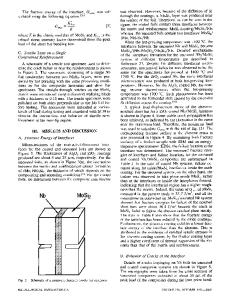Stick-Slip Fracture of Polymer/Metal Interfaces
- PDF / 117,603 Bytes
- 6 Pages / 612 x 792 pts (letter) Page_size
- 65 Downloads / 396 Views
DD7.6.1
Stick–Slip Fracture of Polymer/Metal Interfaces Y. Toivola, B.P. Somerday1, R. Shediac1 and M.P. Ivill2 Dept of Chemical Engineering and Materials Science University of Minnesota, Minneapolis, MN 55455 1 Sandia National Laboratories Livermore, CA 94551 2 Dept of Materials Science University of Florida, Gainesville, FL 32611 ABSTRACT The adhesion of a thin–film of PMMA to substrates consisting of Ti or Al was measured using a four–point bend technique. Initial results revealed that cracks propagated along the PMMA/metal interfaces at stable rates. Subsequent experiments showed intermittent (“stick– slip”) interfacial crack propagation consisting of cycles of crack initiation, unstable propagation, and arrest. To investigate the origin of stick–slip fracture behavior at PMMA/metal interfaces the effect of water uptake by PMMA on fracture behavior was studied. Four–point bend sandwich specimens were stored in vacuum or deionized water environments at either 25 °C or 65 °C for a period of 7 days prior to testing. The PMMA/Al system stored at 25 °C showed a transition from stable to stick–slip crack propagation when the exposure environment was changed from vacuum to water. Interface crack propagation was stable for both the PMMA/Ti and PMMA/Al systems on exposure to 65 °C water, but the critical strain energy release rate, GC was markedly reduced, indicating that water uptake promoted stick–slip fracture up to some critical degree of hydration. No change in stick–slip behavior was observed from a variation in imposed load–point displacement rate. INTRODUCTION The LIGA (Lithography, Galvanoformung, Abformung) process is being utilized for the fabrication of high aspect ratio, free–standing MEMS components [1]. One particular system of interest consists of a PMMA photoresist, which serves as a mold, attached to a metallized silicon wafer, which serves as a conductive base for electroplating. This study focuses on the adhesion between a PMMA photoresist and a metallized silicon wafer substrate where the metal is either Al or a layered structure of Ti–Cu–Ti. Adhesion measurements were made using a four–point bend technique, shown in Fig. 1, which utilizes a sandwich specimen geometry. This specimen geometry is well–suited for the measurement of interfacial adhesion in multi–layered systems [2]. Ideally, the resulting strain energy release rate, G, of a crack propagating within the inner span is independent of crack length. For uniform adhesion under a constant imposed load–point displacement, δ, cracks propagate along the interface at a constant load, and the mechanical energy release rate, G, is 21(1 − ν 2 ) P 2 l 2 G= 16 Eb 2 h 3
(1)
DD7.6.2
where P, is the applied load, l, is the spacing between the inner and outer loading pins, b, is the specimen thickness, h, is the specimen half–height and in this case elastic modulus, E, and Poisson’s ratio, ν, refer to the silicon beams [2].
Figure 1. A schematic representation of the fracture–mechanics based four–point bend experiment applied to “sandwich” specimens c
Data Loading...











